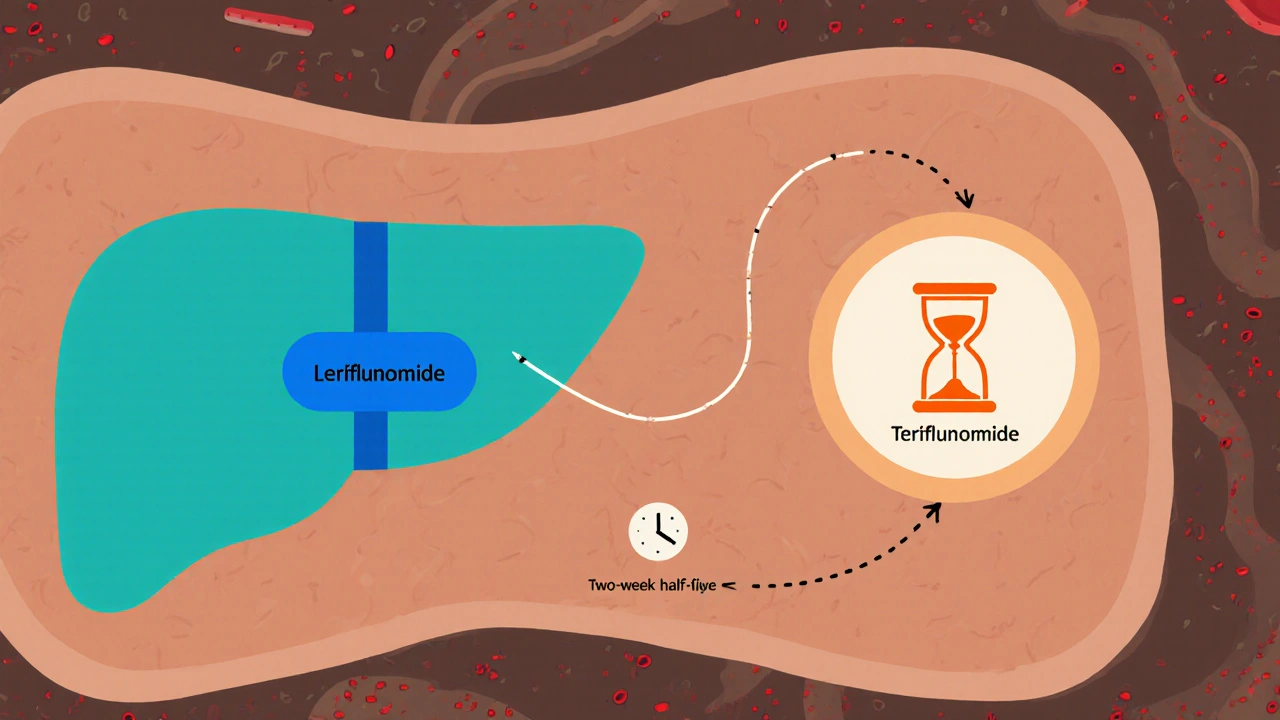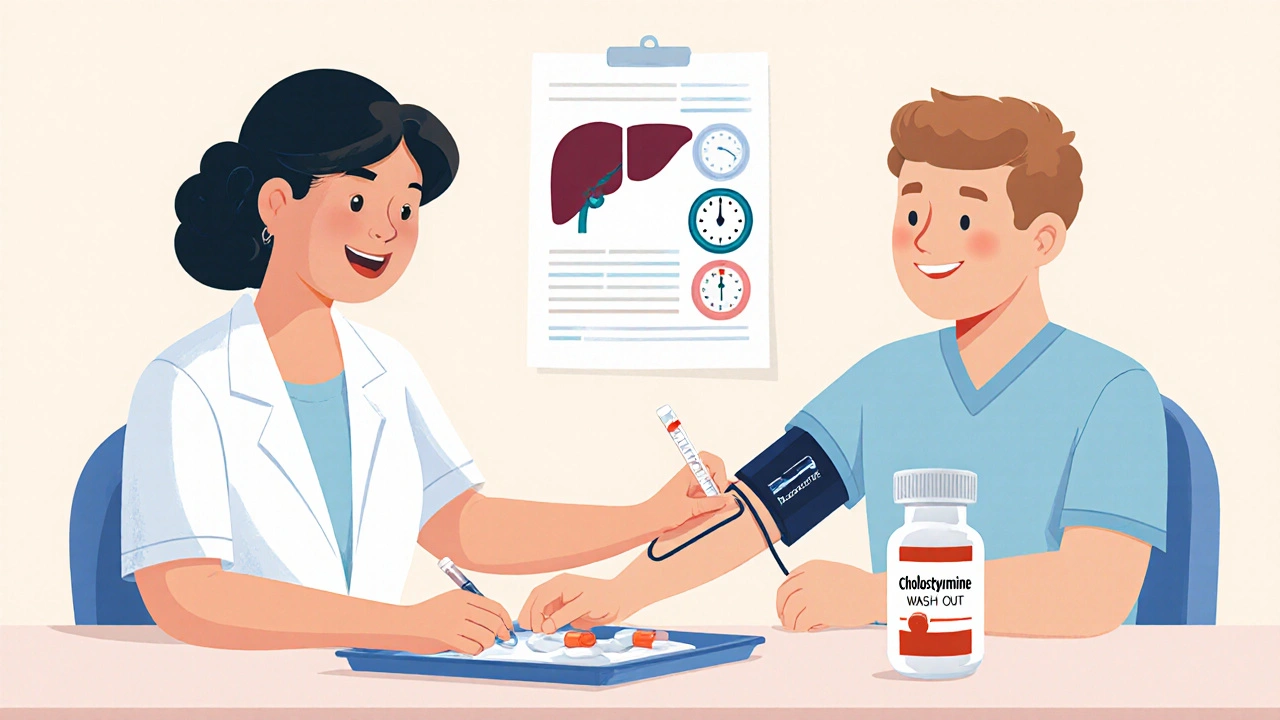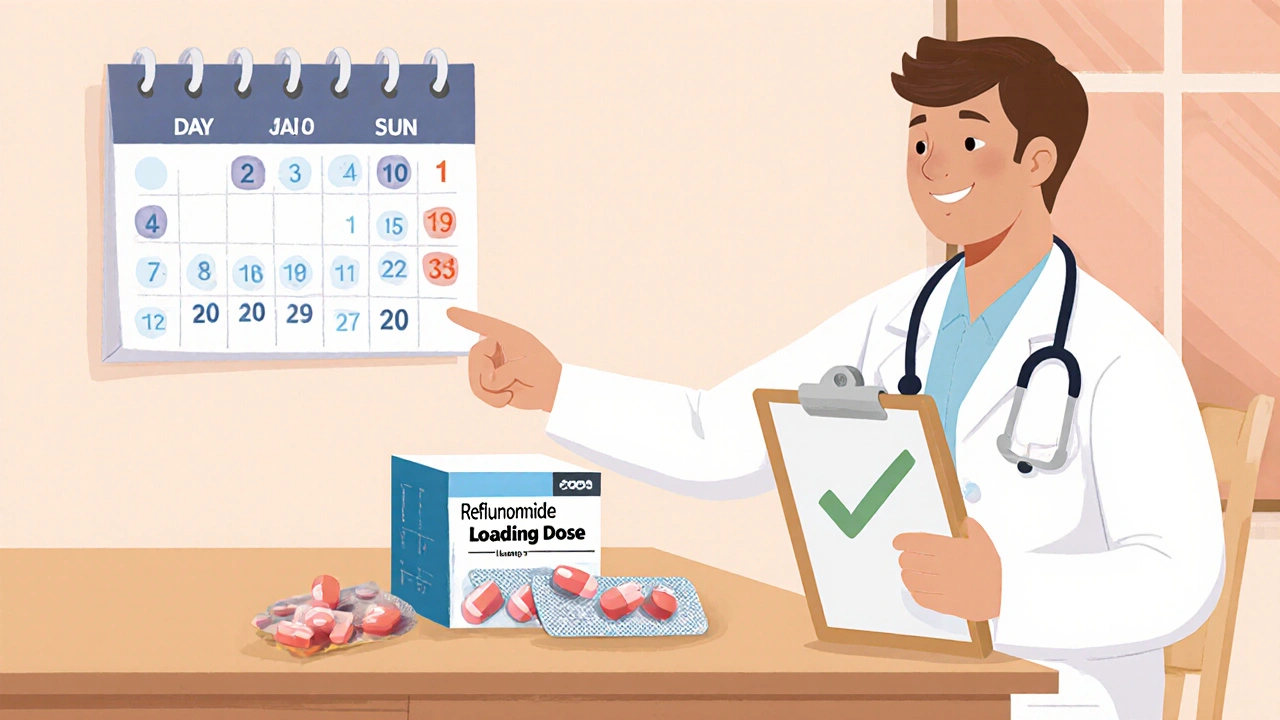Leflunomide Dosage Calculator
Patient Information
Recommended Dosage
Monitoring Recommendations
Quick Takeaways
- Start most adults with 100 mg daily for 3 days (loading dose) then drop to 20 mg daily.
- Maintain 20 mg daily for rheumatoid arthritis; 10 mg may be enough for milder disease.
- Adjust dose if liver enzymes rise >2× upper limit or if plasma teriflunomide >70 µg/mL.
- Pregnant or breastfeeding patients should avoid leflunomide or undergo an accelerated wash‑out.
- Regular monitoring - CBC, liver panel, and blood pressure - keeps side‑effects in check.
Finding the right amount of leflunomide dosage isn’t just about reading the label. It’s a balancing act between quelling inflammation and steering clear of toxicity. Below you’ll get a clear roadmap: from the basics of what leflunomide is, through standard dose recommendations, to the tweaks you’ll need if you have liver concerns, are pregnant, or are switching from another drug.
What is Leflunomide?
Leflunomide is a disease‑modifying antirheumatic drug (DMARD) that suppresses the immune system by inhibiting dihydroorotate dehydrogenase, an enzyme crucial for pyrimidine synthesis. By cutting off the building blocks for rapidly dividing immune cells, it reduces the joint‑destructive process seen in chronic inflammatory diseases.
How Leflunomide Works - The Active Metabolite
Within hours of ingestion, leflunomide is converted in the liver to Teriflunomide, the pharmacologically active metabolite responsible for most of the drug’s effects. Teriflunomide’s half‑life can stretch to 2 weeks, which explains why dose changes or discontinuation take time to show up in the bloodstream.
Standard Dosing Recommendations
Guidelines from the American College of Rheumatology (2023 update) and the drug’s label converge on a two‑step approach:
- Loading phase: 100 mg once daily for three consecutive days. This quickly ramps up plasma teriflunomide levels to therapeutic range (≈30‑70 µg/mL).
- Maintenance phase: 20 mg once daily for most adults. Some patients achieve disease control at 10 mg, especially if they experience mild disease or have a history of liver enzyme elevations.
Typical therapy duration is indefinite, as stopping the drug abruptly can lead to a flare‑up. When a clinician decides to discontinue, a wash‑out protocol with cholestyramine (8 g three times daily for 11 days) or activated charcoal is required to pull teriflunomide out of the body.

Dosage by Indication
While leflunomide is most famous for treating Rheumatoid arthritis, it’s also approved for Psoriatic arthritis. The dosing window is the same, but clinicians may start a bit lower for psoriatic arthritis if skin involvement is the primary concern.
| Condition | Loading Dose | Usual Maintenance | Lower Maintenance (if needed) |
|---|---|---|---|
| Rheumatoid arthritis | 100 mg × 3 days | 20 mg daily | 10 mg daily |
| Psoriatic arthritis | 100 mg × 3 days | 20 mg daily | 10 mg daily |
Patients who have already failed Methotrexate often stay on the 20 mg maintenance dose because the two drugs complement each other’s mechanisms.
When to Adjust the Dose
Several patient‑specific factors can push you to tweak the standard schedule:
- Liver function: If alanine aminotransferase (ALT) or aspartate aminotransferase (AST) rise above twice the upper limit of normal (ULN), drop to 10 mg or hold the drug until enzymes normalize.
- Renal impairment: No formal dose reduction, but clinicians often monitor more closely because teriflunomide clearance can be slower.
- Age: Patients >75 years may start directly at 10 mg daily to reduce early toxicity risk.
- Pregnancy: Leflunomide is teratogenic. Women of childbearing potential must use reliable contraception and, if pregnancy occurs, undergo an accelerated wash‑out with cholestyramine.
- Drug interactions: Concomitant use of strong CYP1A2 inducers (e.g., rifampin) can lower teriflunomide levels, potentially necessitating a higher maintenance dose. Conversely, warfarin may have its effect potentiated, requiring closer INR monitoring.
Monitoring Schedule
Regular labs keep the therapy safe. A typical monitoring plan looks like this:
| Time Point | Tests |
|---|---|
| Baseline (before first dose) | Liver panel, CBC, serum creatinine, blood pressure |
| Weeks 2, 4, 8 | Liver panel, CBC |
| Every 3 months thereafter | Liver panel, CBC, pregnancy test (if applicable) |
If any test shows abnormal values, adjust the dose or pause therapy per the guidelines above.

Special Situations: Switching Drugs and Wash‑Out
When a patient moves from Methotrexate to leflunomide, there’s no required wash‑out because they act via different pathways. However, the opposite direction-stopping leflunomide to start methotrexate-requires a cholestyramine wash‑out to avoid lingering teriflunomide interference.
For patients who need a rapid removal (e.g., planning pregnancy), cholestyramine 8 g three times daily for 11 days reduces teriflunomide plasma concentration to <10 µg/mL, which is considered safe for conception.
Side‑Effect Profile and What to Watch For
Common adverse events (≥10 % incidence) include diarrhea, rash, and alopecia. More serious concerns are hepatotoxicity and hypertension. If you notice new skin lesions, persistent nausea, or a sudden rise in blood pressure, contact your rheumatologist promptly.
Because teriflunomide can linger for weeks, dose reductions may not immediately lower the risk of toxicity. That’s why the wash‑out protocol is vital when discontinuation is medically necessary.
Frequently Asked Questions
Can I take leflunomide if I have mild liver disease?
Mild, stable liver enzyme elevations (≤1.5× ULN) are not an automatic contraindication, but doctors usually start at the 10 mg maintenance dose and monitor liver tests every two weeks for the first two months.
How long does it take for leflunomide to start working?
Patients often notice improvement in joint pain and swelling within 4‑6 weeks, but full therapeutic effect may take up to 3 months because teriflunomide builds up slowly.
Is it safe to combine leflunomide with biologic therapy?
Yes, many rheumatologists pair leflunomide with TNF inhibitors or IL‑6 blockers when monotherapy isn’t enough. The combination can lower the needed dose of each drug, potentially reducing side‑effects.
What should I do if I miss a dose?
Take the missed tablet as soon as you remember, then continue with the regular schedule. If it’s close to the next dose, skip the missed one-don’t double up.
Can leflunomide be used in children?
The drug is not approved for pediatric rheumatoid arthritis in the U.S. Some European studies have explored low‑dose use, but safety data are limited, so it’s generally avoided.
Whether you’re just starting leflunomide or have been on it for years, staying informed about dosage nuances helps you stay in control of your disease and your health.



Comments
They don’t want you to know the hidden risks!!!
Alright, folks, let’s dive deep into why you should never just grab a bottle of leflunomide off the shelf without a proper chat with your rheumatology doc!!! First, the loading dose of 100 mg for three days might sound like a quick fix, but it floods your liver with teriflunomide, the metabolite that sticks around longer than a bad meme!!! Second, if you’re already on methotrexate, mixing these can create a chemical cocktail that even the best labs can’t fully track!!! Third, the standard maintenance dose of 20 mg daily is a sweet spot for many, but some patients feel the side‑effects skyrocket after just a week!!! Fourth, older adults, especially those over 75, should start at 10 mg because their bodies clear the drug slower, and nobody wants an unexpected flare!!! Fifth, if your liver enzymes creep above twice the upper normal limit, you must drop to 10 mg or pause treatment until they settle!!! Sixth, pregnancy is a big no‑no-leflunomide is teratogenic, and the accelerated wash‑out with cholestyramine is not a myth!!! Seventh, the half‑life of teriflunomide can stretch two weeks, meaning you’ll feel the drug’s echo long after you stop!!! Eighth, regular CBC and liver panels every few weeks are essential-don’t skip them just because you feel fine!!! Ninth, remember that drug‑drug interactions with CYP1A2 inducers like rifampin can lower efficacy, so dosing might need a bump!!! Tenth, the wash‑out protocol isn’t a hassle; eight grams of cholestyramine three times daily for eleven days will pull the toxic metabolite out!!! Eleventh, for those with mild psoriatic arthritis, a 10 mg maintenance might be enough, saving you from unnecessary exposure!!! Twelfth, never self‑adjust the dose-talk to a specialist!!! Thirteenth, side‑effects like hypertension can sneak in, so keep an eye on your blood pressure!!! Fourteenth, the guidance from ACR 2023 is solid, but always tailor to individual needs!!! Finally, keep a medication diary, note any new symptoms, and bring it to every appointment-your future self will thank you!!!
Hey there, just wanted to add that monitoring liver enzymes early can save you a lot of trouble - even a small bump should make you pause and talk to the doc. Also, the recommended CBC checks at weeks 2, 4, and 8 are really easy to fit in a regular check‑up. If you’re on contraception, keep the pregnancy test every three months as the guide says. And for anyone switching from methotrexate, you don’t need a wash‑out, just a clean hand‑off. Stay safe and keep those labs up to date.
This drug is a foreign import, not made in our own labs, so why trust it? Our bodies deserve simpler, home‑grown treatments. The big pharma story is clear: they hide side‑effects. Keep looking for alternatives.
We must ask ourselves why the medical community pushes leflunomide with such confidence while keeping the darker side under wraps. It’s not just about inflammation; it’s about control - the pharmaceutical giants want a population dependent on pricey, long‑lasting meds. Think about the accelerated wash‑out: they claim it’s for safety, but it also binds patients to a costly regimen of cholestyramine. The truth is concealed in the fine print, where the risk of teratogenicity is downplayed, and the real cost-both financial and health‑wise-is hidden. When they say “monitor liver enzymes,” they expect patients to bear the burden of endless lab work, while the profit margins soar. The guidelines from 2023 are conveniently vague about age‑related dose reductions, leaving our elders vulnerable. If you believe the system, you accept that your body becomes a testing ground for their latest formula. We need to demand transparency, not just obedient adherence. The moral imperative is to question, to seek second opinions, and to protect ourselves from covert agendas.
Listen up, dear readers, because the story behind leflunomide is far more dramatic than any textbook will let you see. The drug’s active metabolite, teriflunomide, lingers like a ghost for up to two weeks, haunting your system long after the last pill. When the liver tries to clear it, it enlists the aid of cholestyramine, a binder that sweeps the toxin out as if performing a theatrical climax. If you’ve ever wondered why some patients need to switch from methotrexate, it’s because the two drugs perform a delicate dance, each covering the other’s weaknesses, yet never truly harmonizing. In the rare cases where a patient’s creatinine spikes, the doctors often whisper about “closer monitoring” while the underlying story is a battle of metabolic pathways. Even the ACR’s 2023 guidance hides behind polite language, masking the fierce tug‑of‑war between efficacy and toxicity. So, when you pop that 20 mg tablet, remember you are playing a part in a larger drama of immune suppression, liver vigilance, and relentless pharmaceutical intrigue.
Honestly, it’s baffling how some folks just breeze through these dosing charts without a flicker of caution; the responsibility to read the fine print lies with the patient, not the prescriber. Yet, the glossy brochures gloss over liver toxicity like it’s an after‑thought, and we end up with avoidable complications. The colorful language in the guidelines can’t mask the fact that many ignore the periodic blood work, thinking “I feel fine”. Such complacency is a recipe for disaster, especially when teriflunomide hangs around for weeks. If we all played by the rules-monitor, report, adjust-perhaps the drama would be less tragic.
Skipping regular labs on leflunomide is simply irresponsible.
From an Indian perspective, the emphasis on herbal immunity often clashes with reliance on heavy synthetic DMARDs like leflunomide, which can feel like a cultural imposition. The aggressive marketing of such drugs undermines traditional approaches that prioritize diet and lifestyle. While the drug works, the side‑effect profile demands respect, not blind acceptance. Patients should be empowered to consider all options, not just the pharma‑driven ones. Let’s push for a balanced dialogue that honors both modern science and cultural wisdom.